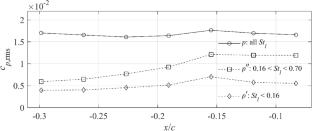This investigation characterized the relation between the breathing motion and wall-pressure fluctuations for a turbulent separation upstream of the trailing edge of a two-dimensional wing with NACA 4418 profile. The experiments were conducted at a freestream velocity U∞ = 10.2 m/s with a turbulent intensity of 0.4%. The wing had an aspect ratio of 1.2 and an angle of attack of 9.7°. The corresponding chord-based Reynolds number was 620,000. The measurements consisted of simultaneously acquired wall-pressure measurements at various streamwise locations and time-resolved particle image velocimetry (PIV) in a streamwise-wall-normal plane. Both measurements showed unsteadiness related to the breathing motion at low Strouhal number Stl ≈ 0.05. Here, Stl is defined based on the characteristic length, l, of the mean turbulent separation bubble (TSB). Cross-correlation between the measured wall pressures at different streamwise locations revealed that the breathing motion propagated at approximately 0.8U∞ downstream of the mean detachment (MD) point. The breathing motion was observed to establish a stronger correlation with the low-frequency wall-pressure fluctuations in the low-intermittency regions as opposed to the high-intermittency regions. Spectral proper orthogonal decomposition was performed using the combined PIV velocity fields and wall-pressure measurements. The results revealed that the expansion (or contraction) of TSB preceded a reduction (or increase) in wall pressure measured upstream of MD and an increase (or reduction) in wall pressure measured downstream of MD. The findings align with the fact that TSB expansion occurs when local adverse pressure gradient (APG) increases, whereas contraction corresponds to a decrease in APG.




